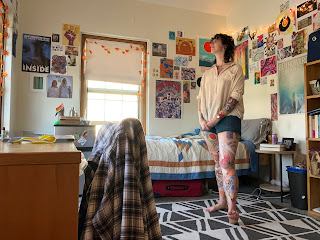carsten holler: reaching back
My research presentation is about Carsten Höller. I argue that his work is constantly reaching towards and striving for the innocent feelings of childlike wonder and awe that we experience in our youth, but always through the now jaded lens of having grown up. So his art pieces all have something to do with childhood and youth, like aquariums, carousels, slides, and bright colors, but they all have this dark, almost obsessive side to them as well.
In a lot of my research, he and other people talk about his work in a different way. He's focused more on distorting perceptions of reality, exploring subjectivity and objectivity of people's perceptions, what is truth, what is opinion. How each person's experience is different but also similar. He's also interested in making people question themselves and their ideas of themselves, filling them with doubt and uncertainty and trying to change their views.
However, the feeling I get when I look at his work is so filled with this tug and pull between childhood and adulthood instead. I see this through the contrast between the materials used and the content/subject matter of the piece. I also see this in the contrast between the external view in the photos of the pieces compared to the way viewers experience them. I think there is something interesting about his work feeling so different when photographed in an empty quiet sterile still way, compared to the life that the sound of children squealing with delight brings. I think the fact that this background stillness and haunting melancholy/nostalgia is still quietly present even when the children are there and people are enjoying his installations in person suggests that this feeling underlies all of his work.
Here is the link to my powerpoint.



Your exploration of Carsten Höller's work through the lens of childhood versus adult perception is thought-provoking. I appreciate how you highlighted the dual nature of his art—invoking nostalgia and joy reminiscent of youth, while also incorporating a darker, more reflective side that speaks to the complexities of adulthood.
ReplyDelete